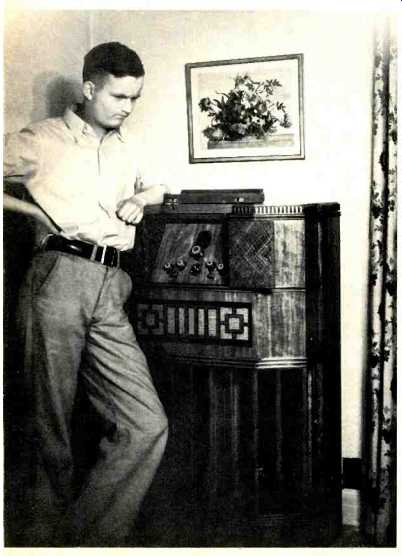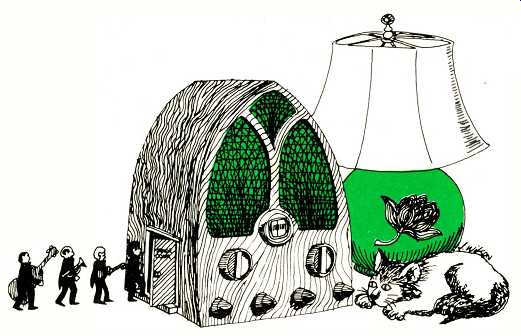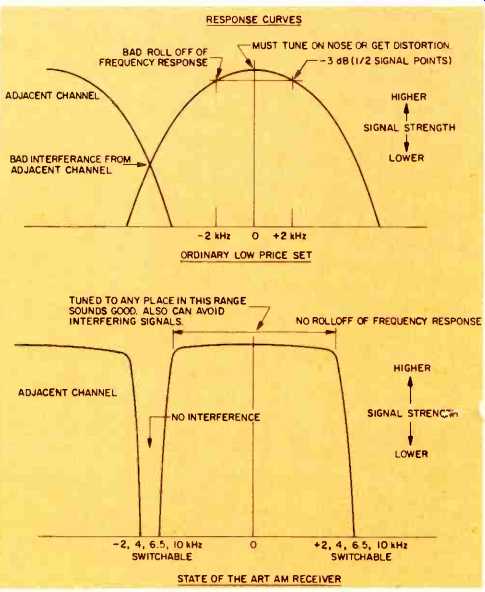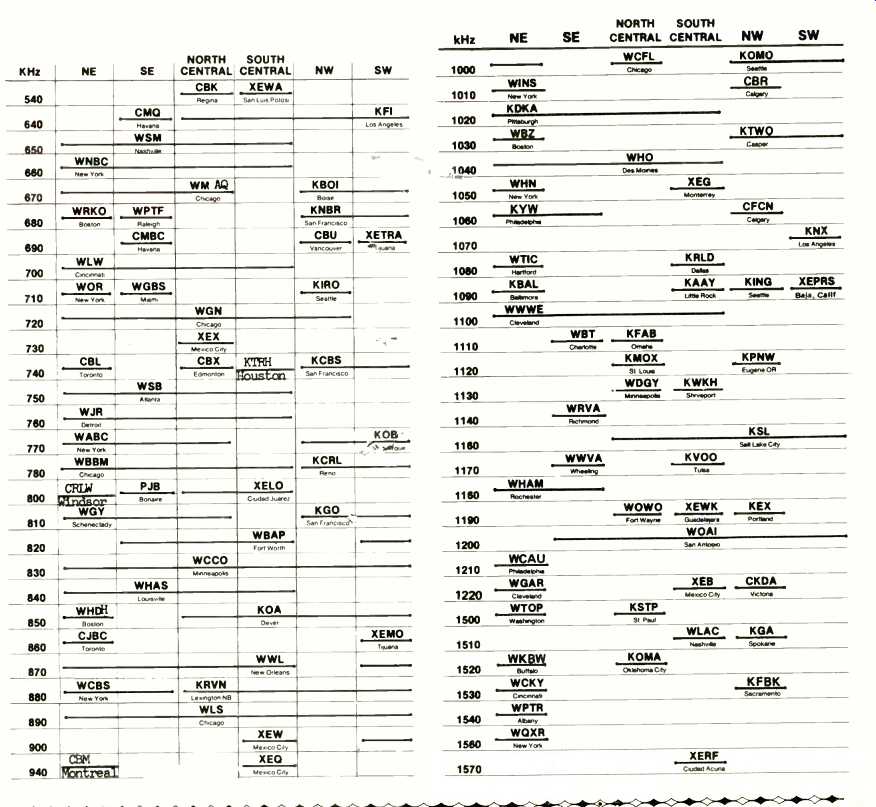
by George McKay, Jr., W6WXG as told to Larry Engard
Are you satisfied with what you can get on the radio?
A little disenchanted with the FM programming?
Think it is useless to try the AM band because of the interference, electrical noise, distortion, and lack of fidelity and signal quality? A lot of people will agree that AM programming has a lot to offer. Many top radio personalities are on AM. All of the sports shows are on AM. There is a greater variety of types of music programming on AM. The top net work news programs are on AM.
With all of this going for it, what is the state of AM broad casting? We hear a lot of people putting AM down, saying it is over the hill, that all that is new and good is on the FM band, and AM is losing popularity. Is this all true? Let's take a good, close look and see! The AM transmitting equipment in use today can send out a signal that is flat 50 to 15,000 cycles. The transmitted signal is clean and distortion free, and full fidelity, except for the case of some few small local stations.
How about on the receiving end? All-band portables and automobile radios, for the most part, have good to high sensitivity, fair to good fidelity with a compromise on band width, dial calibration is generally poor, and ease of tuning is critical. In low-priced portables, table radios and the AM sections of most AM-FM hi-fi receivers and tuners, sensitivity is low, selectivity is poor, frequency response is usually flat only between 150 to 2500 Hz, and distortion is very high with no shielding of electrical interference from fluorescent and neon lights, motors, television sets, electric switches, and all of the other electric consumer products found in the home or office today. Here again, ease of tuning is critical. Let's pursue the question of programming a little further.
Duplication of FM and AM broadcasting occurs in some small markets, but generally, the programming is entirely different. Most networks, except National Public Radio, have their best news programs on their AM affiliates. The news shows are longer, more comprehensive, and more current than the newscasts available on the FM band. AM stations have the top announcers and personalities, even though we have recently seen several big names move over to FM. AM has the talk shows, the phone-in programs, base ball and football games and all the other sports, the religious stations, the top 40, the MOR and the Country/Western music. They are all on AM radio. There are several excellent classical music stations broadcasting on AM. The popularity of AM radio is attested to by the spending of the advertisers dollars, among other things. The only thing FM radio has that AM does not have is stereo and quadraphonic broad casting. There has been some experimentation with stereo AM broadcasting in an attempt to keep up with the sounds of FM stereo and quadraphonic.
However, it is not on the broadcasting end that the weak link in AM is found. No matter how good a signal is broadcast, if there isn't a good antenna and receiver to pick it up and translate it into a good audio signal, there will be no indicator for the listener to know that the transmitted signal was good. You cannot compare the signal of an AM station received on a $25.00 AM receiver with an FM stereo signal interpreted on a $300 tuner with amplifier and dual speakers. Let me reiterate that most signals broadcast on AM have as good a quality and fidelity as most signals broadcast on FM.
Here arises another bit of fiction! We have all heard and read that since distant AM stations are 10 kHz apart on the dial, the FCC restricts frequency response of the AM broad cast signal to 5kHz. Since this is such a narrow bandwidth, it would therefore not be sensible to make high fidelity AM receivers. This whole supposition is fiction, pure and simple! The picture shows me listening to a H.R. Scott receiver in 1936. This receiver had 23 vacuum tubes, and it was a high fidelity receiver. There have been very few high fidelity AM receivers marketed since then; however, it is a fact that back then all locally produced network shows were high fidelity, and all the Western Electric recordings in the 1930s' were produced and broadcast in high fidelity. High fidelity in AM broadcasting has been with us for a long time, is still with us, and I feel will continue to be with us for a long time to come. FM broadcasting, it should be noted, did not begin until January 1, 1941.

Now let's go back to the radio dial. When a station is assigned a frequency, the geographic locations of other stations on the same frequency are considered, along with the power of the station. Stations in the same geographic areas, or with signal patterns in the same area, are separated on the dial by at least 30 kHz, by FCC regulations. This broadens the available frequency response area to 15 kHz. On clear-channel stations and regional stations, the frequency is usually assigned so that the spread is more than 30 kHz. Therefore, in theory at least, clear-channel stations are not limited in station frequency response, though in practice they are limited by complaints. A typical frequency response of an average station can be and most generally is as high as 7,500 Hz, with clear-channel stations going up to 10 kHz.
What does this mean in terms of the human ear? Human auditory capabilities generally range from about 60 Hz to 16 kHz, and many people do not hear the extremes at either end. Therefore, that top harmonic between 7,500 Hz and 15 kHz amounts to very little actual difference. Now, if this 7,500 Hz signal of the average station is reproduced on a low-cost receiver with a bandwidth of 2,500 Hz maximum, the poor audio fidelity of the result should not be blamed on the broadcasting station or AM radio in general.
Filter Bandwidth
Another area we should explore is bandwidth versus fidelity. On AM you can have high fidelity with broad band width or low fidelity with a selective receiver with narrow bandwidth. However, bandwidth does not affect distortion.
A high quality filter has a flat top and steep sides, as opposed to the conventional type filter which gives a rounded cycle type of picture. Figure 1 shows the differences in the two types of filters. The frequency response is represented by half of the bandwidth, which is represented by the "top" of the filter picture. On the flat-top filter with the steep sides, the "top" or bandwidth can be quite broad and still serve the purpose of eliminating unwanted interfering side signals. On the normal round-top filter, we have to accept a compromise between bandwidth and cutting off of interfering signals from adjacent channels. Now, if we have a 13-kHz filter, this will give us a frequency response of 6,500 Hz.
A good AM receiver will, of course, have two bandwidths available: a narrow or sharp position for distant and weak stations, with a response of about 2,500 Hz, and a broad position responding to 9,000 Hz. A state-of-the-art receiver should have several crystal filters ranging from 4 to 20 kHz, giving the receiver a high fidelity range of from 2,000 to 10,000 Hz.

Fig. 1--Flat-top and rounded-top filter characteristics.
Another advantage of the flat-top filter is that tuning is not critical. Setting the dial, or tuning, to any point within the bandwidth range produces a perfectly good sound. The volume does not necessarily peak at just one point on the tuning dial. At times it is advantageous to tune to one side or the other of the center frequency in order to avoid an interfering signal. With a rounded-top filter, slight off-center tuning to avoid interfering signals deteriorates greatly the wanted signal. With a flat-top filter, you can tune out interfering signals without losing quality of the incoming signal over a much greater bandwidth range.
==============

above: AM Stations North America Clear channel AM stations, Most with 50,000
Watts or more.
==============
Antennas
One thing we haven't talked much about yet and which has a great effect on our listening pleasure, be it AM or FM, mono or stereo, is the antenna. The FM antenna, if one is needed, should be placed as high as possible and facing the transmitter tower from which the signal is being broadcast.
The antenna must be within line of sight of the transmitting tower in order for a signal to be received. FM is limited to a maximum distance from the transmitter of about 150 miles.
On the lower power stations, the distance is much less. The signal can also be disturbed or blocked out by such things as mountains and tall buildings between the transmitter and the receiver. On auto radios, either AM or FM, the antenna installation is already done, and the only variable effect we can have is dependent on where we drive the car.
With the average AM receiver or tuner, the placement and installation of the antenna can, and does, have a vast effect on the capture of the r.f. signal and the resultant audio signal. The built-in loop-stick antenna that we find on most AM sections is an adequate, but not really a very satisfactory antenna. It is difficult to tune, subject to heavy TV interference and electrical circuits in the area, and the stations you will be able to receive depend upon the positioning of the receiver in your home.
One alternative to the standard loop antenna is an out side long-wire antenna. First of all, you must have the space to install it. It is usually out of the question in cities, apartment buildings and other areas of high congestion. If you have the area, you must get the wire up high above the ground and string it between two conveniently located trees or erect two towers or poles to hold it up. The lead-in wire from the antenna to the receiver must be installed properly to shield out unwanted interference. Altogether, installation of a long-wire antenna is a rather technical and time consuming undertaking, but it does work well-until the first storm or heavy wind, then usually has to be re-erected.
One more-satisfactory alternative is the tunable loop antenna. This configuration first appeared in the 1920s as a large loop of wire mounted on the top of large table-model Js. It could be turned by hand to act as a directional antenna to increase the incoming signals. The next step was arrange the loop inside of large floor-model consoles, with an exterior tuning knob to control the direction of the loop. This arrangement appeared in the 1930s. Changing furniture fashions and miniaturization of receivers made this type of loop very impractical. The next step was a non-tunable loop of wire wound around the back cover or inside the case of the receiver on a permanently placed, small ferrite stick. Neither of these arrangements offered any shielding or adjusting, and it seems the listening public accepted these mediocre arrangements and has become accustomed to the lower fidelity reception that we normally get now on AM.
Remembering the quality AM reception from the days of my youth, we at McKay-Dynek decided that this quality was still possible and designed an indoor, shielded-ferrite loop antenna specifically for AM radio listening. In simple terms, the antenna consists of a special, heavy, 3/4-by-12-in. high-permeability ferrite rod encased in a shielded cover, mounted on a swivel atop a tunable amplifier. The shielding is constructed so as to allow the wanted r.f. signals to reach the rod while shielding out unwanted distortion and the antenna delivers a clean, interference-free, distortion-free r.f. signal to the antenna posts of the receiver.
The next step we have to consider is what the receiver does with this signal. If you have the average receiver we talked about earlier, it cuts off the "skirts" of the signal and limits the bandwidth. If you are trying to receive a distant or weak signal, this would be acceptable. If you want a strong station, whether local or distant and you want to hear the full fidelity of the broadcast signal without the interference and distortion normally associated with AM, you need a receiver which doesn't cut the signal "skirts." Fortunately there are a few units on the market today which don't do this; McKay-Dynek's AM3 is one. The cost of this tuner is quite high compared with what people are used to paying for an AM radio. However, when you compare it with an FM tuner that would give the same frequency response and the same low distortion, the cost is comparable. For those whose tastes run to the very best available, Dynek will soon announce a state-of-the-art AM tuner with crystal filters, digital frequency readout, very low distortion, and many other features. The price of this tuner will be comparable with the better FM tuners, but still well below several FM tuners on the market.
Stereo AM On the subject of stereo, we mentioned earlier that there have been some trial runs with AM stereo broadcasting. At this point, it is not at all certain that the FCC will approve AM stereo in this country. An AM station in Baltimore has been doing some AM stereo broadcasting, but there has been very little publicity about it. The only way to receive AM stereo broadcasts in this country is to have two receivers, one tuned to the left of the center of the signal, the other tuned to the right. There is an AM stereo receiver available in this country, but it is for export only in sample quantities from Kahn Electronics, Inc., 74 North Main St., Freeport, NY 11520. Mr. Kahn also has a stereo AM transmitter driver-modulator which goes for about $16,000. This is available for foreign broadcasters only. Mr. Kahn says that his new transmitting equipment is superior to his previous model that has been in use by XETRA in Tijuana, Mexico.
Since AM does not require line-of-sight reception as FM does, it is easy to conclude that if AM stereo does become available and practical in the U.S., it will be preferable for automobile listening and a valuable addition to a home sound system for its varied programming.
There are a few other points I wish to make about AM broadcasting in general. Amplitude modulation transmission is actually a carrier frequency with side bands that is used to transmit radio frequency signals in the electromagnetic spectrum in a range of from 150 to 26,100 kHz in many separate frequency bands. When we talk about the broad cast band in this country, we are covering only the range from 540 to 1600 kHz which is usually referred to as the medium wave band. In audio circles in Europe and North Africa, the bands usually referred to are the long wave band, from 150 to 300 kHz, and the medium wave band, 540 to 1600 kHz, The long wave band is used very little for broad casting except in Europe, North Africa, and the Soviet Union. The main characteristic of the long wave band is that it has very long range, during both daytime and nighttime hours. We here in the United States may be losing a lot by not using the long wave band to relieve some of the congestion in the AM broadcast band. The range of this band is put to good use by BBC Radio 2 on 200 kHz. They cover all of Western Europe and the United Kingdom in the day time.
The medium wave frequencies of 540 to about 1000 kHz have long range characteristics during daylight hours. From 1000 to 1500 kHz, the range that the broadcast signal will cover shortens quite considerably during the daylight hours.
At nighttime, the clear-channel stations in the 540 to 1600 kHz band have very long range characteristics. There are about 70 of these clear channel stations scattered around the country, and their signals cover great distances. The remainder of the 4,413 AM stations share their frequencies, and dependent on their strength, location, signal patterns and location, transmit their signals over a range as short as 5 miles and up to 100 miles from their transmitter.
There are a lot of AM stations out there in the 107 AM channels on the broadcast band. With the proper receiving equipment you can enjoy a lot of good radio listening.
(Audio magazine, Jan. 1975)
Also see:
AM Stereo: An FCC Fiasco (July 1982)
FM Fidelity: Is The Promise Lost? (March 1985)
The Problem with FM (March 1985)
New Specs for the New Tuners (Jan. 1973)
= = = =